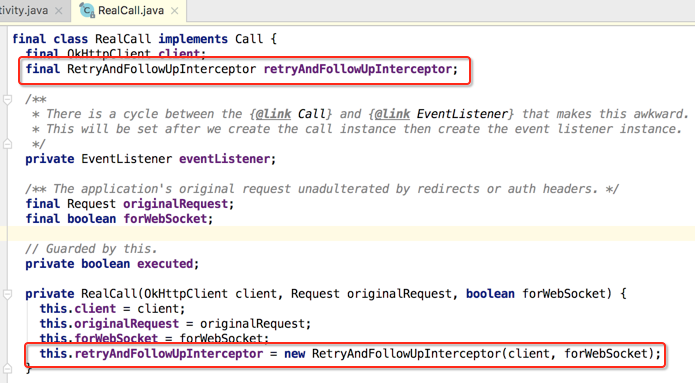okhttp拦截器之RetryAndFollowUpInterceptor&BridgeInterceptor分析
在上一次【https://www.cnblogs.com/webor2006/p/9096412.html】对okhttp的拦截器有了一个初步的认识,接下来则对具体的拦截器一个个进行了解。
RetryAndFollowUpInterceptor:
按照添加拦截器的顺序来分析,首当其冲的就是这个重试拦截器啦,如下:

而它是在RealCall构造时所创建的:

从这个类的名字来看应该它就是用来网络异常重连用的,那具体实现细节还得从源码上来进行观察,我们知道对于拦截器中最核心的方法是intercept()方法,所以直接将焦点定位到该方法:

那它是干嘛的呢?从名字来看貌似是分配流的,下面还是看一下官方对它的说明:

虽说它是定义在RetryAndFollowUpInterceptor中,但是并没在为之所用,而真正用到的是在之后要分析的ConnectInterceptor中,如下:


主要是用于连接服务端的connection和用于服务器进行数据传输的输入输出流,这个在未来ConnectionInterceptor中进行进一步分析。
那对于okHttp的拦截器都是通过RealInterceptorChain这个对象来进行链接起来,直到所有的拦截器都走完才会返回response对象,那假如期间出现了异常那咱们的这个重试拦截器是如何发挥作用的呢?

然后其它的一些重试逻辑这里先不细看,看一个跟重试特别相关的代码,如下:
@Override public Response intercept(Chain chain) throws IOException {
Request request = chain.request();
RealInterceptorChain realChain = (RealInterceptorChain) chain;
Call call = realChain.call();
EventListener eventListener = realChain.eventListener();
streamAllocation = new StreamAllocation(client.connectionPool(), createAddress(request.url()),
call, eventListener, callStackTrace);
int followUpCount = 0;
Response priorResponse = null;
while (true) {
if (canceled) {
streamAllocation.release();
throw new IOException("Canceled");
}
Response response;
boolean releaseConnection = true;
try {
response = realChain.proceed(request, streamAllocation, null, null);
releaseConnection = false;
} catch (RouteException e) {
// The attempt to connect via a route failed. The request will not have been sent.
if (!recover(e.getLastConnectException(), false, request)) {
throw e.getLastConnectException();
}
releaseConnection = false;
continue;
} catch (IOException e) {
// An attempt to communicate with a server failed. The request may have been sent.
boolean requestSendStarted = !(e instanceof ConnectionShutdownException);
if (!recover(e, requestSendStarted, request)) throw e;
releaseConnection = false;
continue;
} finally {
// We're throwing an unchecked exception. Release any resources.
if (releaseConnection) {
streamAllocation.streamFailed(null);
streamAllocation.release();
}
}
// Attach the prior response if it exists. Such responses never have a body.
if (priorResponse != null) {
response = response.newBuilder()
.priorResponse(priorResponse.newBuilder()
.body(null)
.build())
.build();
}
Request followUp = followUpRequest(response);
if (followUp == null) {
if (!forWebSocket) {
streamAllocation.release();
}
return response;
}
closeQuietly(response.body());
if (++followUpCount > MAX_FOLLOW_UPS) {
streamAllocation.release();
throw new ProtocolException("Too many follow-up requests: " + followUpCount);
}
if (followUp.body() instanceof UnrepeatableRequestBody) {
streamAllocation.release();
throw new HttpRetryException("Cannot retry streamed HTTP body", response.code());
}
if (!sameConnection(response, followUp.url())) {
streamAllocation.release();
streamAllocation = new StreamAllocation(client.connectionPool(),
createAddress(followUp.url()), call, eventListener, callStackTrace);
} else if (streamAllocation.codec() != null) {
throw new IllegalStateException("Closing the body of " + response
+ " didn't close its backing stream. Bad interceptor?");
}
request = followUp;
priorResponse = response;
}
}
也就是有一个最大重试次数,可以看一下定义的是多少次:

所以可以总结一下该拦截的一个核心流程:
1、创建StreamAllocation对象。
2、调用RealInterceptChain.proceed(...)进行网络请求。
3、根据异常结果或者响应结果判断是否要进行重新请求。
4、调用下一个拦截器,对response进行处理,返回给上一个拦截器。
BridgeInterceptor:
接着按着顺序来分析第二个拦截器:

那它主要是用来干嘛的呢?先看一下官方的注释说明:

有了一个大概认识之后下面来看一下它的源码,当然焦点还是定位到intercept()方法啦:
@Override public Response intercept(Chain chain) throws IOException {
Request userRequest = chain.request();
Request.Builder requestBuilder = userRequest.newBuilder();
RequestBody body = userRequest.body();
if (body != null) {
MediaType contentType = body.contentType();
if (contentType != null) {
requestBuilder.header("Content-Type", contentType.toString());
}
long contentLength = body.contentLength();
if (contentLength != -1) {
requestBuilder.header("Content-Length", Long.toString(contentLength));
requestBuilder.removeHeader("Transfer-Encoding");
} else {
requestBuilder.header("Transfer-Encoding", "chunked");
requestBuilder.removeHeader("Content-Length");
}
}
if (userRequest.header("Host") == null) {
requestBuilder.header("Host", hostHeader(userRequest.url(), false));
}
if (userRequest.header("Connection") == null) {
requestBuilder.header("Connection", "Keep-Alive");
}
// If we add an "Accept-Encoding: gzip" header field we're responsible for also decompressing
// the transfer stream.
boolean transparentGzip = false;
if (userRequest.header("Accept-Encoding") == null && userRequest.header("Range") == null) {
transparentGzip = true;
requestBuilder.header("Accept-Encoding", "gzip");
}
List<Cookie> cookies = cookieJar.loadForRequest(userRequest.url());
if (!cookies.isEmpty()) {
requestBuilder.header("Cookie", cookieHeader(cookies));
}
if (userRequest.header("User-Agent") == null) {
requestBuilder.header("User-Agent", Version.userAgent());
}
Response networkResponse = chain.proceed(requestBuilder.build());
HttpHeaders.receiveHeaders(cookieJar, userRequest.url(), networkResponse.headers());
Response.Builder responseBuilder = networkResponse.newBuilder()
.request(userRequest);
if (transparentGzip
&& "gzip".equalsIgnoreCase(networkResponse.header("Content-Encoding"))
&& HttpHeaders.hasBody(networkResponse)) {
GzipSource responseBody = new GzipSource(networkResponse.body().source());
Headers strippedHeaders = networkResponse.headers().newBuilder()
.removeAll("Content-Encoding")
.removeAll("Content-Length")
.build();
responseBuilder.headers(strippedHeaders);
String contentType = networkResponse.header("Content-Type");
responseBuilder.body(new RealResponseBody(contentType, -1L, Okio.buffer(responseBody)));
}
return responseBuilder.build();
}
首先是给咱们的request添加各种请求头用于接下来的http请求,其中可以看到一个很熟悉的头:

接下来则请求获取response对象:



所以这里再将其进行总结一下:
1、是负责将用户构建的一个Request请求转化为能够进行网络访问的请求。
2、将这个符合网络请求的Request进行网络请求。
3、将网络请求回来的响应Response转化为用户可用的Response。
okhttp拦截器之RetryAndFollowUpInterceptor&BridgeInterceptor分析的更多相关文章
- okhttp拦截器之CallServerInterceptor解析
今天来学习OkHttp的最后一个拦截器,如下: 看一下它的javadoc说明: 其作用有两个:发起网络请求和接收服务器响应,下面具体来看一下它的intercept(): 下面具体来看一下: 接着就是读 ...
- okhttp拦截器之ConnectInterceptor解析
主流程分析: 继续分析okhttp的拦截器,继上次分析了CacheInterceptor缓存拦截器之后,接下来到连接拦截器啦,如下: 打开看一下它的javadoc: 而整个它的实现不长,如下: 也就是 ...
- okhttp拦截器之CacheInterceptor解析
在上一次[https://www.cnblogs.com/webor2006/p/9150658.html]了解了缓存的存与取的细节之后,接下来就可以分析一下OkHttp的缓存拦截器啦: OkHttp ...
- OkHttp3 拦截器源码分析
OkHttp 拦截器流程源码分析 在这篇博客 OkHttp3 拦截器(Interceptor) ,我们已经介绍了拦截器的作用,拦截器是 OkHttp 提供的对 Http 请求和响应进行统一处理的强大机 ...
- 从网络请求过程看OkHttp拦截器
前言 之前我们结合设计模式简单说了下OkHttp的大体流程,今天就继续说说它的核心部分--拦截器. 因为拦截器组成的链其实是完成了网络通信的整个流程,所以我们今天就从这个角度说说各拦截器的功能. 首先 ...
- Okhttp同步请求源码分析
进阶android,OKhttp源码分析——同步请求的源码分析 OKhttp是我们经常用到的框架,作为开发者们,我们不单单要学会灵活使用,还要知道他的源码是如何设计的. 今天我们来分析一下OKhttp ...
- Okhttp3源码解析(5)-拦截器RetryAndFollowUpInterceptor
### 前言 回顾: [Okhttp的基本用法](https://www.jianshu.com/p/8e404d9c160f) [Okhttp3源码解析(1)-OkHttpClient分析](htt ...
- ABP中的拦截器之ValidationInterceptor(上)
从今天这一节起就要深入到ABP中的每一个重要的知识点来一步步进行分析,在进行介绍ABP中的拦截器之前我们先要有个概念,到底什么是拦截器,在介绍这些之前,我们必须要了解AOP编程思想,这个一般翻译是面向 ...
- Okhttp拦截器统一异常处理并多次读取response.body().string()
参考:https://blog.csdn.net/a624806998/article/details/73863606 引言: 写这篇文章,因为在自己编写实现Http日志拦截器的时候,在拦截器中使用 ...
随机推荐
- 《精通并发与Netty》学习笔记(13 - 解决TCP粘包拆包(一)概念及实例演示)
一.粘包/拆包概念 TCP是一个“流”协议,所谓流,就是没有界限的一长串二进制数据.TCP作为传输层协议并不不了解上层业务数据的具体含义,它会根据TCP缓冲区的实际情况进行数据包的划分,所以在业务上认 ...
- STL标准模板库之set
目录 一.关联式容器 二.什么是set? 特点 优缺点和适用场景: 三.定义及初始化 四.基本操作 1)容量函数 2)修改函数 3)迭代器 4)其他函数 五.与序列容器的不同点 一.关联式容器 关联式 ...
- shell学习笔记2-find和xargs
1,find命令形式 find pathname -options [-print - exec -ok] pathname find命令所查找的目录路径.. 表示当前目录,/表示系统根路径 -pri ...
- windows下编译libnet0.10.11
以下编译基于windows下visual studio 2013 (注:编译安装完成之后发现与网上的arp教程中使用的libnet不是一个版本,这个版本太老了,最后没有使用. 网络教程上使用的是lib ...
- ML.NET 1
ML.NET 示例:目录 ML.NET 示例中文版:https://github.com/feiyun0112/machinelearning-samples.zh-cn英文原版请访问:https:/ ...
- 关于 layer.open 动态赋值不了的问题
前情: layer.open({ type:1, // 用的是默认的信息弹框 content: $('#test'), // 这里不用 $('#test').html(), 不然后面获取不了值 }); ...
- js统计页面中各个标签出现的次数,倒序排列
// html <html> <div>hello</div> <div>world</div> <a href="&quo ...
- 关于日志slf4j+logback&logback.xml配置
1.maven依赖 <!-- https://mvnrepository.com/artifact/org.slf4j/slf4j-api --> <!-- <dependen ...
- hdu 6319 逆序建单调队列
题目传送门//res tp hdu 维护递增单调队列 根据数据范围推测应为O(n)的. 我们需要维护一个区间的信息,区间内信息是"有序"的,同时需要在O(1)的时间进行相邻区间的信 ...
- 题目15 链表中倒数第K个节点
///////////////////////////////////////////////////////////////////////////////////// // 5. 题目15 链表中 ...
